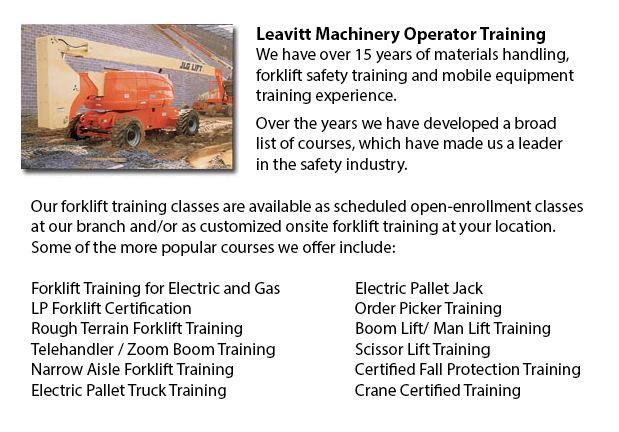
Kelowna Boom Lift Safey Training - Boom lifts fall under the type of elevated work platform or aerial lifting device. Most usually used in warehousing, construction and industry; the boom lift is so versatile that it could be utilized in almost whatever surroundings.
Elevated work platforms enable personnel to get into work areas which will be unreachable otherwise. There is inherent danger in the operation of these devices. Employees who operate them should be trained in the right operating methods. Accident avoidance is paramount.
Boom Lift Training Programs cover the safety aspects involved in boom lift operation. The program is best for those who operate self-propelled boom supported elevated work platforms and self-propelled elevated work platforms. Upon successful completion of the course, Individuals who participated would be issued a certificate by someone qualified to confirm finishing a hands-on assessment.
Industry agencies, federal and local regulators, and lift manufacturers all play a role in establishing standards and providing information so as to help train operators in the safe utilization of elevated work platforms. The most important ways to prevent accidents connected to the utilization of elevated work platforms are as follows: checking machinery, wearing safety gear and conducting site assessment.
Key safety considerations when operating Boom lifts:
Operators stay away from power line, observing the minimum safe approach distance (MSAD). Voltage can arc across the air to find an easy path to ground.
To be able to maintain stability when the platform nears the ground, a telescopic boom should be retracted prior to lowering a work platform.
People working from the platform of a Boom lift should tie off in order to guarantee their safety. Safety harness and lanyard combinations should not be connected to any anchorage other than that provided by the manufacturer, never to other poles or wires. Tying off may or may not be necessary in scissor lifts, depending on particular job risks, local rules, or employer guidelines.
The maximum slope would be specified by the manufacturer. Workers must avoid working on a slope, whenever possible. When the slope exceeds recommended situation, the lifting device should be transported or winched over the slope. A grade could be simply measured by laying a straight board or edge of at least 3 feet on the slope. Then a carpenter's level can be laid on the straight edge and the end raised until it is level. The per-cent slope is obtained by measuring the distance to the ground (also called the rise) and then dividing the rise by the length of the straight edge. Next multiply by 100.
-
Kelowna Forklift Training Program
Kelowna Forklift Training Program - The lift truck is a common powered industrial vehicle which is in wide use these days. They are sometimes called hi los, lift trucks or jitneys. A departments store would use the forklift to unload and load merchan... More -
Kelowna Crane License
Kelowna Crane License - Crane operators ought to be "credentialed", that means they ought to have a crane operator certification or license. Credentialing is considered a mandatory governmental requirement in order to practice as an operator of a cra... More -
Kelowna Loader Training
Kelowna Loader Training - Loader Training - Any individual who would like to operate a forklift should take a Loader Training course in order to become a certified forklift truck operator. There are a variety of ways to obtain forklift training. Cour... More -
Kelowna Aerial Lift Safety Training
Kelowna Aerial Lift Safety Training - Each and every year, there are roughly 26 construction deaths attributed to the use of aerial lifts. Most of the craftsmen killed are electrical workers, laborers, painters, ironworkers or carpenters. The majorit... More -
Kelowna Crane Ticket
Kelowna Crane Ticket - Modern cranes can either be simple or complex, based upon the nature of the application they can carry out. For example, mobile cranes are somewhat simple units. A telescopic boom and even a steel truss mounts its movable platf... More -
Kelowna Boom Lift Operator Training
Kelowna Boom Lift Operator Training - The cherry picker work platform is a type of work platform, that will typically have a bucket or platform at the end of a hydraulic lifting system. The machine is likewise referred to as a man lift, boom lift, hy... More -
Kelowna Heavy Equipment Ticket
Kelowna Heavy Equipment Ticket - Depending on the nature of the job at hand, the kind of construction equipment that a heavy equipment operator makes use of differs. Every kind of machine is made to perform particular tasks in the most effective mann... More -
Kelowna Bucket Truck Training
Kelowna Bucket Truck Training - The bucket truck training program is a program that is intended to effectively train qualified operators so they can reduce the possibility of incident and personal injury while working with or in close proximity to bu... More

Leavitt Operator Training
TOLL FREE: 1-888-254-6157
101-864 McCurdy Place
Kelowna, British Columbia
forkliftcertificationkelowna.com
Email Us
About Us


